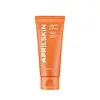What's inside
What's inside
 Key Ingredients
Key Ingredients

 Benefits
Benefits

 Concerns
Concerns

 Ingredients Side-by-side
Ingredients Side-by-side

Water
Skin ConditioningCI 77004
Cosmetic ColorantBentonite
AbsorbentMethylpropanediol
Solvent1,2-Hexanediol
Skin ConditioningSodium Hyaluronate
HumectantChlorella Vulgaris Extract
Skin ConditioningCitrus Aurantium Bergamia Fruit Oil
MaskingCitrus Aurantium Dulcis Peel Oil
MaskingCitrus Grandis Peel Oil
MaskingCynanchum Atratum Extract
Skin ConditioningDaucus Carota Sativa Root Extract
Skin ConditioningAlthaea Rosea Flower Extract
Skin ConditioningCanola Oil
EmollientDaucus Carota Sativa Seed Oil
EmollientHelianthus Annuus Seed Oil
EmollientDaucus Carota Sativa Root Water
MaskingTetrasodium Pyrophosphate
BufferingMagnesium Aluminum Silicate
AbsorbentCaprylyl Glycol
EmollientCellulose
AbsorbentGlucose
HumectantButylene Glycol
HumectantAllantoin
Skin ConditioningFructooligosaccharides
HumectantFructose
HumectantEthylhexylglycerin
Skin ConditioningSodium Phytate
Tocopherol
AntioxidantCanadian Colloidal Clay
Skin ConditioningCapryloyl Salicylic Acid
ExfoliatingGluconolactone
Skin ConditioningZinc PCA
HumectantMontmorillonite
AbsorbentIllite
AbrasiveBeta-Carotene
Skin ConditioningTocopheryl Acetate
AntioxidantXanthan Gum
EmulsifyingCaffeine
Skin ConditioningO-Cymen-5-Ol
AntimicrobialLimonene
PerfumingCI 77491
Cosmetic ColorantCI 77492
Cosmetic ColorantWater, CI 77004, Bentonite, Methylpropanediol, 1,2-Hexanediol, Sodium Hyaluronate, Chlorella Vulgaris Extract, Citrus Aurantium Bergamia Fruit Oil, Citrus Aurantium Dulcis Peel Oil, Citrus Grandis Peel Oil, Cynanchum Atratum Extract, Daucus Carota Sativa Root Extract, Althaea Rosea Flower Extract, Canola Oil, Daucus Carota Sativa Seed Oil, Helianthus Annuus Seed Oil, Daucus Carota Sativa Root Water, Tetrasodium Pyrophosphate, Magnesium Aluminum Silicate, Caprylyl Glycol, Cellulose, Glucose, Butylene Glycol, Allantoin, Fructooligosaccharides, Fructose, Ethylhexylglycerin, Sodium Phytate, Tocopherol, Canadian Colloidal Clay, Capryloyl Salicylic Acid, Gluconolactone, Zinc PCA, Montmorillonite, Illite, Beta-Carotene, Tocopheryl Acetate, Xanthan Gum, Caffeine, O-Cymen-5-Ol, Limonene, CI 77491, CI 77492
Water
Skin ConditioningKaolin
AbrasiveMelia Azadirachta Leaf Extract
Skin ConditioningPropylene Glycol
HumectantBentonite
AbsorbentFuller's Earth
AbrasiveCurcuma Longa Root Extract
MaskingParfum
MaskingSodium Methylparaben
PreservativeImidazolidinyl Urea
PreservativeDMDM Hydantoin
PreservativeXanthan Gum
EmulsifyingDisodium EDTA
Sodium Propylparaben
PreservativeCitric Acid
BufferingSodium Lauryl Sulfate
Cleansing
 Reviews
Reviews

Ingredients Explained
These ingredients are found in both products.
Ingredients higher up in an ingredient list are typically present in a larger amount.
Bentonite is an aluminium phyllosilicate clay with great absorbent properties. The name 'bentonite' comes from the area where the largest source is found: Fort Benton, Wyoming.
As a clay, bentonite is often used to absorb excess oil and provide exfoliation. It has also been shown to have some antibacterial and anti-inflammatory properties. Studies show bentonite was effective at calming dermatitis from poison ivy and in diaper dermatitis of infants. Bentonite has also been shown to act as a barrier against toxic compounds on your skin.
Sunscreens containing bentonite display higher water resistance and stay on the skin for much longer. The sunscreens containing bentonite also show higher potency and UV light absorbtion.
Bentonite is naturally created from volcanic ash and several natural weathering/hydrothermal processes.
A common usage of bentonite is removing excess protein from white wines. Bentonite contains a property of being able to absorb large amounts of protein from aqueous solutions.
Phyllosilicate clay has a structure formed by sheets.
Learn more about BentoniteWater. It's the most common cosmetic ingredient of all. You'll usually see it at the top of ingredient lists, meaning that it makes up the largest part of the product.
So why is it so popular? Water most often acts as a solvent - this means that it helps dissolve other ingredients into the formulation.
You'll also recognize water as that liquid we all need to stay alive. If you see this, drink a glass of water. Stay hydrated!
Learn more about WaterXanthan gum is used as a stabilizer and thickener within cosmetic products. It helps give products a sticky, thick feeling - preventing them from being too runny.
On the technical side of things, xanthan gum is a polysaccharide - a combination consisting of multiple sugar molecules bonded together.
Xanthan gum is a pretty common and great ingredient. It is a natural, non-toxic, non-irritating ingredient that is also commonly used in food products.
Learn more about Xanthan Gum